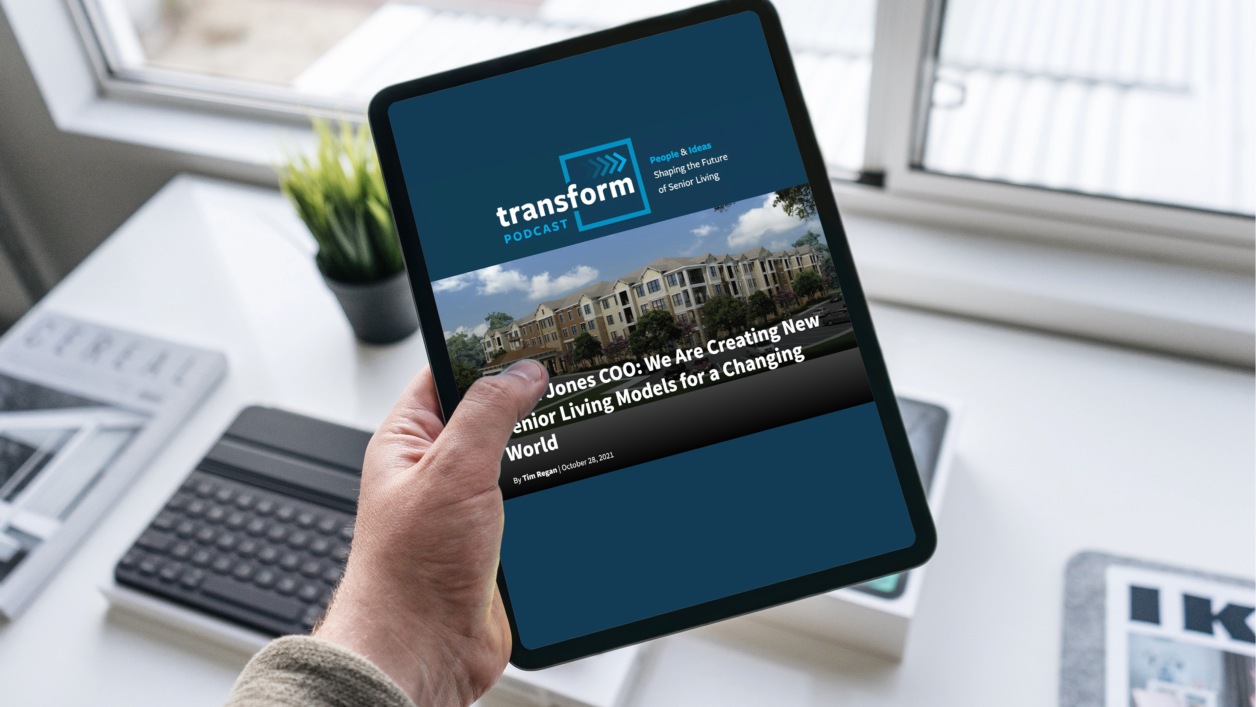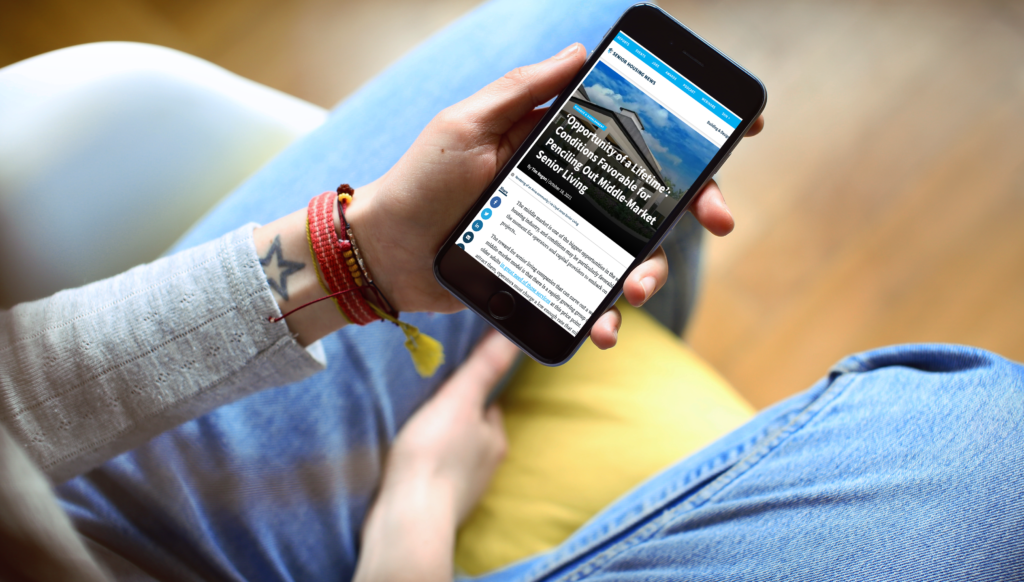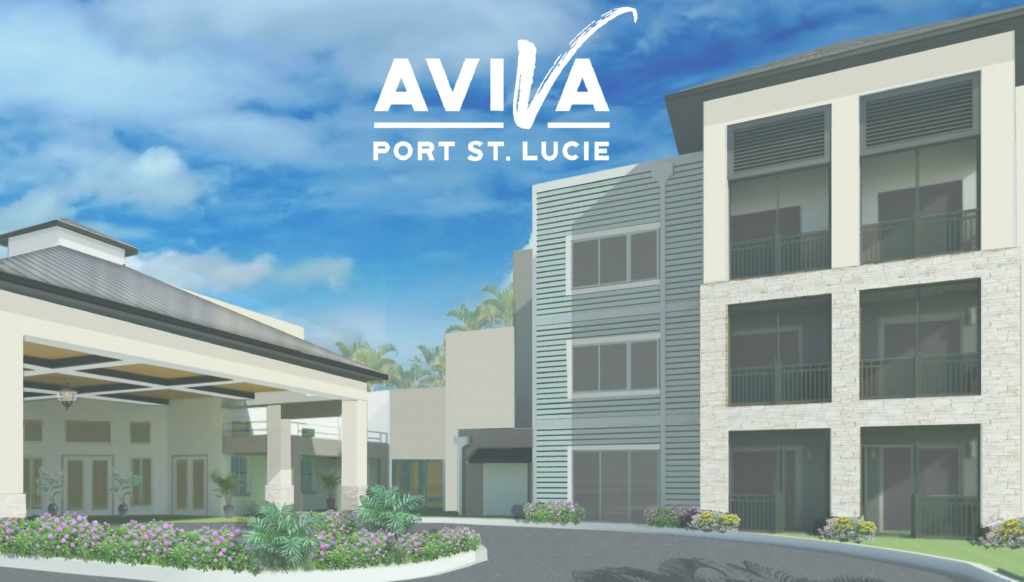By Tim Regan
The middle market is one of the senior living industry’s emerging fronts, and there are many philosophies regarding making it work.
According to Lloyd Jones COO and EVP of Senior Housing Tod Petty, the sector represents an “opportunity of a lifetime” — if you have the right team to make it work.
“Primarily, you have to be vertically integrated,” Petty said during a recent appearance on the Senior Housing News podcast, Transform. “You need an interior design person, you need a construction manager, you need a VP of development, you need remote desktop servicing that you have in-house.”
Using this formula, Miami-based real estate investment and management company Lloyd Jones is creating new middle-market communities with the goal of setting rates at about $1,000 below the market average.
The company also is forging ahead with new concepts under the AVIVA brand umbrella, including converting hotels into active adult communities offering one meal a day for residents, which is uncommon among other operators in the space. And, Lloyd Jones is working with investor partners to pay staff more and change the usual model in response to new workforce realities.
Highlights of Petty’s podcast interview are below, edited for length and clarity. Subscribe to Transform via Apple Podcasts and SoundCloud. The interview took place in late October.
On Lloyd Jones’ presence in the senior housing space:
Lloyd Jones is an investment, development and management firm, and we’re based in the financial district of Miami, Florida; in beautiful Brickell Bay. The firm actually has been in business since 1980, and we have $1 billion in our portfolio that we’re managing.
Chris Finlay has been the chairman and he’s been with the company since 1980. He led it primarily in the multifamily space. We have vertically integrated platforms: an investment development division headquartered in Miami; our multifamily division in Ponte Vedra, Florida; and the senior housing manager, which I run, is located in Atlanta, Georgia.
Lloyd Jones has had senior housing assets within this portfolio for about 20 years. I joined the senior housing division in 2019 to run the division, so this is my fourth time creating a senior housing platform. Right now, we have eight assets under management, we have two new development projects coming out of the ground, and I have four assets under contract we’re going to close prior to the year-end. Our goal is to grow by 1,000 to 1,500 units a year, and we’re pretty excited about what lies ahead.
Chris met with me several times over a six-month period as I was concluding my tenure with a company where I was targeting middle-income. I was CEO — I added 10 communities to the portfolio — and prior to that, I had brought 26 resort-style buildings out of the ground. So, I had resort experience, I had middle market experience, and I met Chris Finlay, who wanted to do it all. We hit it off, and I joined the firm in 2019 with a goal of building a high growth senior housing platform with opportunistic value-add and core to core-plus brands.
On why Petty considers the middle-market an “opportunity of a lifetime”:
This is the second time I’ve used the statement ‘opportunity of a lifetime.’ The last time I used it was in 2008, when the iPad had just come to market and this thing called WiFi was taking off. Hotels were putting WiFi in their entire buildings and making it accessible to guests, and I remember being at the National Investment Center [conference] and asking people on a panel who were my heroes in the industry, ‘What’s going to change in senior housing?’
And they shared with me … ‘No one’s going to adopt this and seniors don’t want WiFi. These devices are just toys, and it’s not going to be around very long. We may put it in the common areas, but we’re not going to do anything with it.’
And I saw a golden opportunity to own the innovation space. So, I took a pre-opening budget and put technology into it. Now, everybody has those buildings. They have innovation and technology — and boy, did we really miss the mark in the early days, thinking that this was going to be a trend. I feel like we’re here again.
I actually moderated a panel with some very good stakeholders in the industry. And we were talking about what’s changed, and they basically said, post-Covid-19, nothing’s going to change. The buildings will be the same, and they’re just waiting for occupancy to get back to a reasonable stabilization rate. But I want to share why I think there is an opportunity of a lifetime, and that basically is [due to] demographics, psychographics and a pandemic.
So here’s some great statistics. First of all, there’s 46 million seniors who are 65 and older living in the United States. We’ve heard that number before. In 2030, baby boomers will be included in this demographic group and are now eligible for housing in this new continuum that we’re going to have. By 2030 … we will have a massive shortage of senior housing. The demand for senior housing is only going to increase, we’re actually in a low right now because of births. We have pent-up demand because of a pandemic, and there’s going to be a great need for housing.
The interesting thing about the middle market primarily is this: The baby boomer generation lacks personal liquidity. Right now more than half of American consumers that are over the age of 55 lack any retirement plans.
The last statistic I saw said they had $6,000 in savings. In the last 10 years, everybody has run this resort model that is only affordable to the top 10% of the market. They all have the same model, and traditional equity follows this model. It’s about 100 units, it’s 80% AL, 20% memory care, it reaches the top 10% of the market, and has a certain NOI that it spins off and a return on investment.
The lower-income folks have some housing and the government help, and the top 10%, their needs are met. But what about the middle market? The opportunity is to create a product that is affordable for this massive housing shortage that’s going to exist for people who can’t get in this resort model. And I know we’ve heard people say, ‘Hey, no one understands it. We can’t get there.’ But I think we already have.
The rates for a middle market [product] are going to come in about $500 to $1,000 less than AL/memory care market rate in any given area, whether it’s an MSA, a secondary or tertiary market. The goal is creating a business model where, instead of $5,000 on rent, they are at $4,000. Or if the market’s rate is $4,000, how do we get it to $3,000?
And remember, the average length of stay is coming down in AL/memory care. We used to see, 20 years ago, lengths of stay as high as 36 months. Now people are coming in, and the stay is roughly 18 to 20 months. The goal is for an affluent person to sell their home, take their equity income into a resort product and be able to pay $5,000 or $6,000 rent for the next 20 months. The middle-market person can’t do that with a $175,000 home or a $225,000 home, but they can if the rents are $1,000 less.
On acquiring properties and turning them into middle-market senior housing:
First of all, 70% of the market is performing fairly well. We have some decline in occupancy, but that’s to be expected. But 30% is very distressed, and there are decisions being made right now by REITs that are unloading and disposing of 20-year vintage assets.
Those assets are now coming on to market, and you also have single owners that built 20 years ago. They stayed full at 95% and did well until new competition came up out of the ground around them. They could have done well with lower rents, but the reason they didn’t is because there was oversupply in the market and the resort-style properties dropped their rents. Eventually, [the resort-style communities] are going to go back up in their rents, but it has hurt a lot of these independent small owners. So, now they’re exiting, and they’re letting go of these properties at $130,000 a unit.
The thought used to be, well, no one is going to want to move into these properties, because they’re 20 years old, they’re smaller units and they’re not amenitized like the new properties. But there are opportunities if you find the right one.
We’re looking right now at acquiring an asset that’s $130,000 a unit. I think the going rate now to build is $220,000 in replacement costs. What’s so great about this is, it’s 160 units of AL/memory care built 20 years ago. It’s very dated — it needs an infusion of about $6 million in CapEx, but all the units are one-bedroom, with kitchens at 800 square feet. So I have a building that’s going to offer my clients 800 square feet of living space, all one unit, with a kitchen. We’re putting that in new product now in memory care, for various reasons. We [will] upgrade this building, and put in a tech package that will even exceed the resort product down the road: RFID door locks and access control, digital signage, music throughout. It’s an inviting and friendly atmosphere.
As a person deciding to spend $800 at the Ritz Carlton, they’ll open my door and say, ‘Hello, Mr. Petty, we’ve been waiting for you,’ and I’m paying $800 a day for the amenities. Or, I can go to a nice bed and breakfast where I walk in and it’s beautiful, there’s a lot of love in the building, I’m getting three meals, I’m getting music playing and aromatherapy, I’m getting the same result — and I can spend $300 a day. If I’m going to stay a month, I’m going to the bed and breakfast. So, we’re repositioning these assets to serve that purpose.
Another opportunity that we’re seeing are hotel owners getting out of the space. Again, It’s all about targeting the right hotel.
If I get the right hotel that a REIT owns and they’re trying to exit — if it’s got good bones, we can combine suites and end up with about 800 square feet [per unit]. We’ve got great common areas, and we can put in an independent or an active adult community and get to that $1,000 price point less than everybody else in the market. All things being equal, I’ll have a renovated building with the same square footage, with the same amenities, and with different programming. If I’m $1,000 less than a person down the road that’s brand new, we’re going to attract the folks that do not have the dollars to spend, those who do not want to spend their savings on it or the adult children who do not want them to spend their inheritance on it.
We’re looking right now at a hotel offering. We have an LOI on a 10-story, concrete-block high rise building, it’s in a highly sought out MSA area, it’s easily 75% below replacement costs. It’s had a full [property improvement plan] on it since 2014. And we want to repurpose the hotel for independent living. So think about this: indoor/outdoor pools, huge common areas, renovated space, but our average rent will be $2,895, with 75% of the units one-bedrooms. The new competitors are at $3,500 down the street.
I think the biggest obstacle is that most people have hired premium third-party vendors. I appreciate them all, and you can hire third-party premium vendors who do everything in the building and have a fantastic deliverable. But you can’t hire third-party premium vendors in the middle market space. You need some, but primarily you have to be vertically integrated.
You have to have a team together, and it’s clunky at first. But you need an interior design person, you need a construction manager, you need a VP of development, you need remote desktop servicing that you have in house. You have to vertically integrate to drive that expense down to offer this product to our customers who are paying $1,000 less.
On Lloyd Jones’ AVIVA sub-brands:
We’re really excited about our multi-brand strategy.
We have an AVIVA brand we’re rolling out that’s a Class A asset brand that is going to be market rate. Specifically, we have a property coming out of the ground in Port St. Lucie. We’re going to have an AVIVA Select brand, which is not a CCRC and there’s not an equity buy-in, but it is designed for the affluent market in an MSA. We will have higher rents, and it will be a membership-based offering. Then we have a middle-market brand that is going to be called Sage Hill.
The average age in assisted living now is at 86.67. One in two after the age of 85 [has dementia]. According to the Alzheimer’s Association, one in three has Alzheimer’s. That age is climbing every year by 80 basis points.
The problem we’re all facing is that we’re going to experience brain failure at 85, even though we’re living longer. Seventy-five percent of the folks moving into AL/memory care … now need a health care product. They didn’t need that 20 years ago. It was all about custodial care, medication, bathing, dressing, grooming and some amenities. When the pandemic hit, what did everybody care about? They wanted safety, they wanted security, they wanted to know Mom was getting her medication.
For those 85 and older, you have a bifurcation. By the time I don’t remember who I am, where my keys are at … it’s time I need care, and I want to go to a health care model. And I think that changes in the future for AL/memory care.
Think about the people under 85: the fastest growing divorcing group in the United States is 75-plus — and why? Well, they didn’t think they were going to live as long as they were with that person. And then you have the folks that are losing a spouse during that decade of their 70s and 80s. They have these big homes, they want to manage their wealth, they’re selling their homes, they have to move someplace they want, to go be near their grandkids. Where do they go?
They’re going to walk into an AL/memory care, and quite frankly, I don’t care how good a salesperson I am, I’m not going to sell them on a place that’s providing mainly care to people that are declining and are cognitively impaired.
So what are they going to want? They’re going to want to go someplace where they can move into one and two bedrooms, they can be around people their own age, they can successfully age in place. They’re going to want the point-of-sale bar, they’re going to want to do a shot at four o’clock, they want to smoke a cigar, they’re probably going to have some version of the Bumble app. This is the Woodstock generation. I have a product for that. But not only do I have a product for that, we want to overlay it with technology — and I don’t mean bells and whistles.
What happens when I need meds now? Well, in any community .. they’re going to say you need our AL/memory care services, or you need to move. Well, I am going to have such robust WiFi that my residents will have their own network with 50 megabytes of download speed. And this is key: I can call a third-party health care partner to come in. I’m going to call a preferred pharmacy to put their machine on my wall and be able to deliver the med to the resident in a package that they can take three times a day … based on time. With the service of a professional third party, I don’t have to move now. And if I need a shower … I’ve got a third party health care person that can come in, they can bathe me, and they’re going to charge me. But with the bathing and dressing charge, the medicine charge and my rent, I’m still lower than an AL/memory care. And I can get Medicare Part A, Part B, OT/PT, speech therapy. I can bring a massage therapist and I can bring salon services in. I can give them telehealth. So, I’m going to stay there probably six years, until one day I’m declining, and now I’m willing to go into an AL/memory care.
So, the AVIVA product we have coming out of the ground, in independent living it’s going to be membership-based with two meals a day, and they’ll have access to amenities. We’ll have a lifestyle engagement director — think a utilization review manager, social worker or a discharge planner that coordinates services. I’m betting that a 75- to 85-year-old will go there all day long, and they’ll wait till they have to go to AL/memory care.
We do something similar with AVIVA Active Adult. In the last six months, I’ve been listening to people on stages telling me that if you’re providing a meal at an active adult community, then you don’t have active adult — and I totally disagree.
We have a model now where we’re converting a hotel and repurposing it for active adult. It includes one meal a day, because I believe someone will pay a premium for a rental space with services with one meal. That’s insurance for a middle-market person.
We have a property coming out of the ground that is going to be higher than most market rents in our area, but slightly. I think the client is going to demand something different, and plus, I have to figure out from the business side what’s the unique value proposition over my competitors.
We think the world is changing, so I’m putting washers and dryers in my AL suites. And the reason I’m doing that is because, do you in a post-Covid-19 world want to mix the laundry with everyone else down the hallway? The number two problem is losing laundry in these communities. If we have another pandemic and we have to retreat to our rooms, I don’t want my residents in a 300-square-foot suite with no washer/dryer and no ability for the families to come in and cook. So, we’re also putting small but full kitchens in our communities. We think that’s a game changer.
We’re going to introduce a much-needed product … transitional living. We’ll have an OT/PT person that’s going to be dedicated to these residents, we will charge more for them and they’ll have their own activities and their own programming that will be appropriate for them separate from the general population. Even though they’ll still participate in some of those, we think that’s going to be a real value-add. We’re also adding a Montessori dementia program.
And the last thing is a — I don’t have a better word for this — fee-for-service strategy for pricing. I want to be able to assess and say, we now have to provide insulin injections and the monitoring of their insulin. So I’m going to charge a diabetic management fee, and we provide insulin monitoring and insulin injections. That’s what you’re getting, and that’s what we charge you for. If you’re on oxygen, I’m going to charge for oxygen services. I think that’s a game changer for our industry. I’m not sure why we haven’t done it, but we’re going to do that with our new AL/memory care coming out of the ground locally [in Atlanta].
On staffing challenges:
I think several things have to change.
One of the reasons I left the resort space after doing 26 versions of it is I saw a lot of people excited about the high amount of rent they were going to get from these clients. There was a chase to create the biggest and largest building. I was jumping up and down and saying you can’t run the same [staffing] ratios.
So, [they were] trying to build for a license that would not allow them to keep higher acuity levels and because there was no one with an understanding of all this, these buildings got built, these pro formas got baked in. Even when the pandemic hit, there was resistance to allow more staffing to come in to increase ratios, which only created more problems for the operator that already was probably understaffed.
The good news is that there’s been a lesson with debt and equity partners. The assets that we have now in the portfolio, we’ve got long-term staff that have been there a while. We sought to recognize them and celebrate them, and we pushed our investors to financially reward them.
There’s a thought sometimes that the team members are only as good as the last P&L. I just think that’s devastating to morale in a building, so there’s a lot of change going on. But we can build pro formas with our investors, and we are putting in higher wages. We’re starting $15 to $17 for our cooks, our housekeeping, our CNAs and our care staff.
I think there’s an understanding that returns are going to be a little bit less on NOI. But if we’re making that up on a low basis in the building, and we’re going to make it up on higher rents with more programming on the other side of it.
But it is a new world, and I think we’re going to have to rethink, moving forward, what we’re going to do. I remember even five years ago, again, asking the question, ‘Hey, are we going to change the way we underwrite these deals from a feasibility study?’ I even asked, if we locate in resort areas, where’s the labor pool coming from? What’s the provision in the pro forma to bring people from 20 miles away into this area, because they don’t live here? It was just, ‘Oh, we’re not worried, this is a great deal.’ And then when it gets up and running, now [they] don’t have team members to provide critical care, which is the product. So, I wish I had a better answer. I’m searching the network every day to figure out what solutions are coming. It’s going to be a change we have to get ready for.



